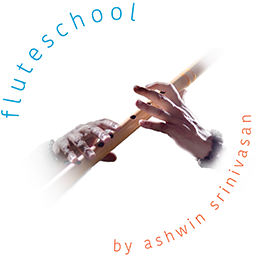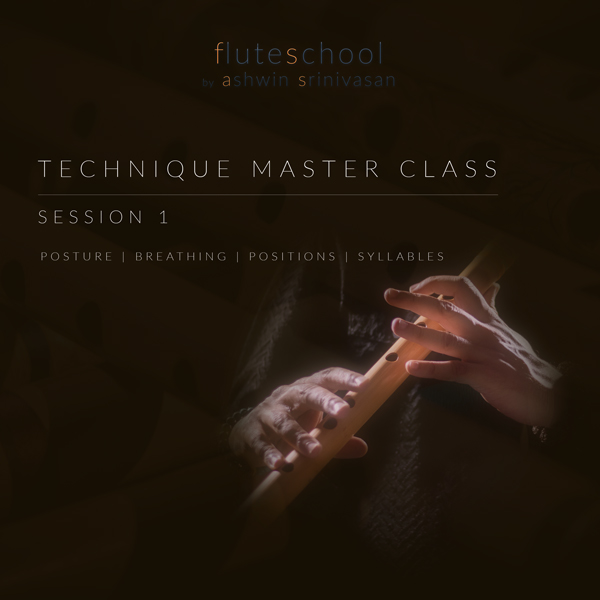
Ashwin Srinivasan
Forum Replies Created
Very nice Anurag ji. Keep at it! The pancham hole needs some more practice. it is a process and the progress will be slow but definite. Looking forward to more!
(Apologies for the delayed response. Too much hectic travel schedule)
A.
Jaideep ji, the ideas and flow is very nice! Your understanding of the Raag is quite comprehensive! I would ask you to pay attention to the little nuances in your finger movements. Specially in your meends. I feel they can sound a little more detailed and timed better also.
Also, try to use Tatkaar in your taans and Jhaala. It will communicate your thoughts better to the listener. Rest, we shall discuss in the meet! 🙂
Wow! Beautiful! I like the folk tune better (didn’t recognise the song, though). With Hamsadhwani, or any other Raag based Bandish, I always try to look for phonetic interpretations of the words through tatkaar. You will find an elaborate lecture on that in the technique Master Class https://ashwinflute.com/courses/bansuri-technique-masterclass-season-1/ Do look it up. And we shall discuss on these videos on this month’s meet. 🙂
ashwinflute.com
Bansuri Technique Masterclass - Season 1 - Ashwin Srinivasan
2+ Hours of Recorded Zoom Video Session explaining Bansuri Technique.
Ashwin Srinivasan
Administrator26/04/2025 at 10:04 pm in reply to: Excited to join this forum! My first video for assessment.Dear Prasad ji, The emotions in your playing are very faithful to the song. But as I must, I will give a critical feedback here – There is a lot of scope for attention to detail. Minute movements like Gamak, meend murki etc can be played with more depth rather than what seems like sticking to easy muscle memory movements (like the murki you have repeatedly applied on the Re-Ga notes). Hope to hear more from you! thanks for posting 🙂
The rhythm aspect is very much on point. But during this entire recording, you seem to have lost focus of the Tanpura. That makes most of the komal notes a little off key and some places even some of the khatkas are sounding jerky. The root Sa itself was sharp. My apologies for the delayed response, and special apologies for the ‘to the point’ (curt) response. Because I have heard much better pitching from you, I feel it is a matter of practicing the method of focussing on the Sur itself. Kindly attempt again, and this time I shall strive to respond a lot sooner 🙂
A
Namaste ji. I just heard your submission on the student showcase page.
The alaap is extremely soothing and tempered. Beautifully done! Hope you are continuing the long notes exercises. That will give you stability on the notes. I can hear the struggle on a few places where you have held the notes a little longer. Also, work on the meend exercise. This will help you strengthen the hold over the instrument and also get better command over what speed you want the meend to be played at.
One word of advice – please try to play along to recordings of seniors and try to emulate what they are doing. This helped me tremendously as a beginner, and sped up my progress considerably.
Thank you :):)
Very impressive and delicately handled Komal Notes! Of the three videos, I liked this one the best. Though, I must insist that you try to play these songs with tabla accompaniment, even if on the app. The feel and expressiveness is already there, and will only be better with the tabla!
Critical Observation – MUST work a lot harder on meend, please 🙂
PS: No sugar-coating done here 🙂
I have similar observations on this one too as I had in the Singaar video.
This is beautiful on its own, but may I suggest also using the tabla (set to the relevant taal and tempo) and practice / perform this (and all other songs)? 🙂
PS: Slightly pitchy in the antara..
I feel the gamaks need more emotion (even if it is a rudimentary exercise)
There is an overall sense of excitement which gives me an impression of rushing through the notes
Also, around the 00:52 mark, the gamaks have become khatkas.
These are my observations. Looking forward to your subsequent submission 🙂
The whole point in those alankars is for you to use your ears to follow the notes. I have always maintained (and it is true) that music is an aural art form. So the learning should use minimal visual help (like tuners or notations) – unless you are learning a song and would like to keep a notation sheet for reference.
There is a fundamental approach to vocal music on any instrument – This is based on syllables. We use strokes of the tongue to depict the syllables. With respect to aakar, as it is a vowel sound, we avoid the tongue and use finger technique to move between the notes. An elaborate explanation for this has been given in the Indore Workshop. Please watch that for an in-depth understanding for Gayaki ang on Bansuri.
There is also a mention of the 23 unique vowel and consonant sounds we can produce on the bansuri using the tongue – this can be found in the technique master class course. Do watch that too! 🙂
Hope this helps!
As many Thaats as you can manage. Preferably all of them from the exercise video
Technically, yes. they are the same. But they vary in application of such glissando.
Whereas in Indian music, meend is where the music is actually said to reside (“What happens between the two notes is where the actual music is” – because of the expressiveness with which such meend can be applied), in western music, glissando is mostly used as an articulation to reach the next note. (Only fretless instruments and a few brass instruments use glissando. Piano, the concert flute (and a few other woodwinds), melodic percussion instruments such as glockenspiel and vibraphone don’t use glissando.
Specific articulations such as meend and alap are almost impossible to notate in the western notation (in my limited knowledge). Someone who knows more can correct me if I am wrong here, please.
On a different note (pun unintended), it is always helpful to learn the western notation system as, for the most part it is easy to communicate with other musicians with it as a general idea for any piece of Indian music.
Indian session musicians, specially from the 1960s through the early 2000s have relied on a hybrid of the Bhatkhande system and vernacular script. An evolved version of which I have developed, taking heavily also from the Ravi Shankar system of writing (in English – using SRGMPDNS) and the western system of Bars and Beats to arrive at a point where my notation system encompasses almost all that I have needed to read and play on my instrument. Especially during my non-classical pursuits. You may find this being used in most of my courses here.
This system is available to learn in both Hindi and English as a course here on https://www.ashwinflute.com/courses/nwce/
Do give this a try 🙂
ashwinflute.com
Introduction to a New and Comprehensive Indian Notation System - ENGLISH - Ashwin Srinivasan
A unique and very ‘Indian’ Method to writing Notaions for Indian Music


